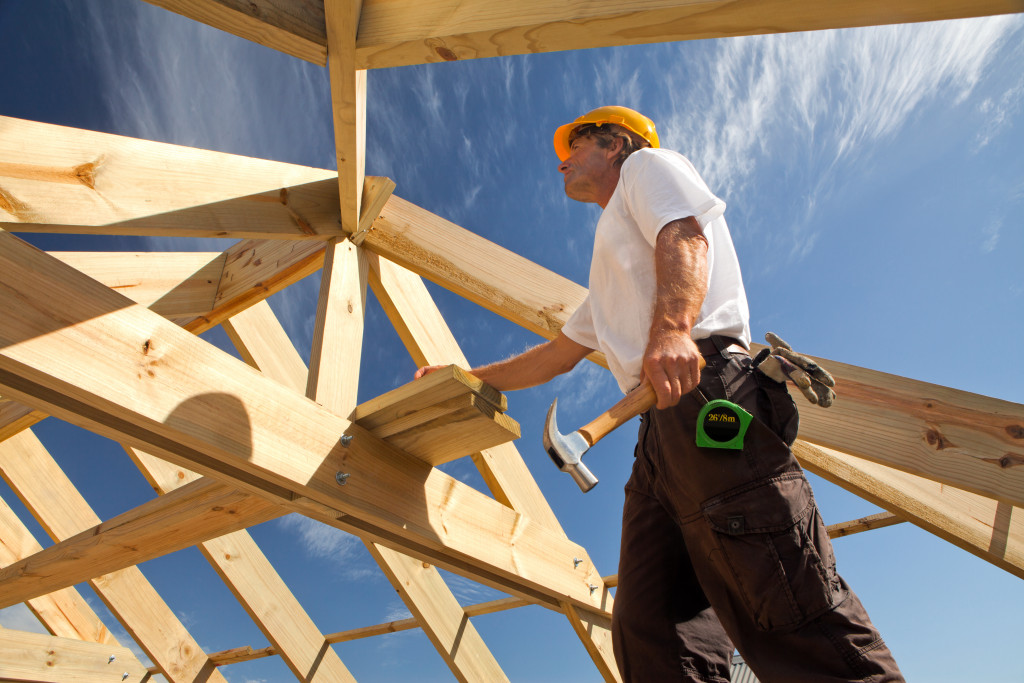Our need for shelter is a basic requirement of human survival. We aren’t going to stop building homes or public structures anytime soon. Yet, the construction industry accounts for nearly 40% of global emissions. And this conflicts with our collective need to stem the growing climate crisis.
The materials used in any construction project will have a major impact on its carbon footprint. On the surface, cutting down trees to build might seem the least environment-friendly option. But wood offers significant sustainability advantages over the other two common materials, concrete and steel.
Wood is a naturally renewable resource. Trees only need water, sunlight, soil, and time to grow. By contrast, the ecological cost of extraction and refining raw materials for concrete and steel is immense.
Well-treated wood can last for centuries. Measures such as sanding hardwood floors, for example, can renew the finish without any need for replacement. That’s not an option for spalling concrete or corroded steel, which require new material to be applied.
But this doesn’t mean the use of wood in construction is green in every way.
Careful sourcing pays off
The growth of a tree doesn’t require any fossil fuels. But felling and transporting lumber to its eventual destination certainly does. Many wood products aren’t sourced from forests within the US. In general, the further away wood, or any material, has to come from to reach your construction site, the greater its transportation-related emissions.
Where you source wood also matters for regulatory purposes. The Forest Stewardship Council (FSC), for instance, certifies that products are sourced in a manner that’s compliant with high standards of social and environmental responsibility. But FSC-certified forests are still predominantly found in Europe, especially Western Europe.
For these reasons, a material such as bamboo might not be as green as you’d think. Indeed, bamboo grows rapidly, is an effective carbon sink, and has a high durability-to-weight ratio. But the varieties of bamboo that are best suited to construction purposes are often grown in Asia, Africa, or South America. In such locations, it’s harder to be certain that your supply of material is being generated responsibly.
Sustaining the environment

Responsible sourcing of your wood materials also ties into the bigger picture of preserving entire ecosystems. When wood is sourced from properly managed forests, it doesn’t just affect the trees themselves. It means that forestry experts are using ethical methods of controlling populations of other species, whether weeds or white-tailed deer, that could hinder the regeneration of trees if left unchecked.
Good forest management doesn’t mean aiming to completely exterminate pests or anything that might interfere with the timber productivity of a forest. It doesn’t involve using chemicals to fertilize the soil in favor of accelerated growth for the desired tree species. It means taking the entire ecosystem into account, including the roles that other species might play in ensuring overall balance and robustness and striving to maintain its health.
Likewise, well-managed forests don’t permit the felling of endangered species for timber. If you’re looking into a supplier that deals in rare woods, such as Brazilian or African mahogany, teak, ebony, or wenge, think twice. These exotic materials come at a high cost to both your project’s budget and the planet itself.
Reusing makes it greener
For all its drawbacks, steel has one redeeming quality in terms of sustainability. It can be recovered and recycled to a great degree, as much as 98% of structural steel, according to the American Institute of Steel Construction.
Steel can be reforged and reworked from scrap, because it can be melted down in electric arc furnaces. Wood isn’t as easy to reclaim and repurpose. If it’s been neglected or severely damaged, wood may no longer be suitable for use in construction.
However, many wood products near the end of their life cycle can still contribute to construction in engineered wood. This is a man-made composite consisting of multiple types of wood in different layers. Waste wood scraps, strands, fibers, and flakes are often mixed in with additives like glue or resin to create a thick, durable board that can withstand structural stress and weathering.
The takeaway is that while wood is the most environmentally friendly of the major construction materials, its carbon footprint can still vary greatly depending on how it’s sourced and used. There must be a greater emphasis on planning and design in future projects. This will allow you to select truly green products in the right applications that will play to their strengths without adversely impacting the environment.

